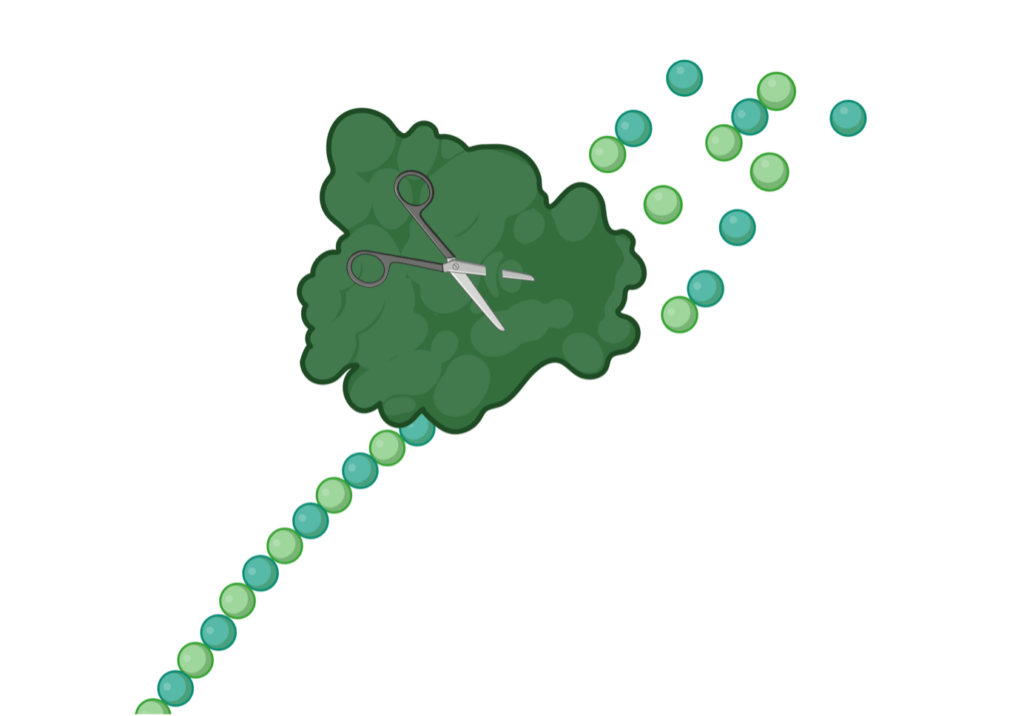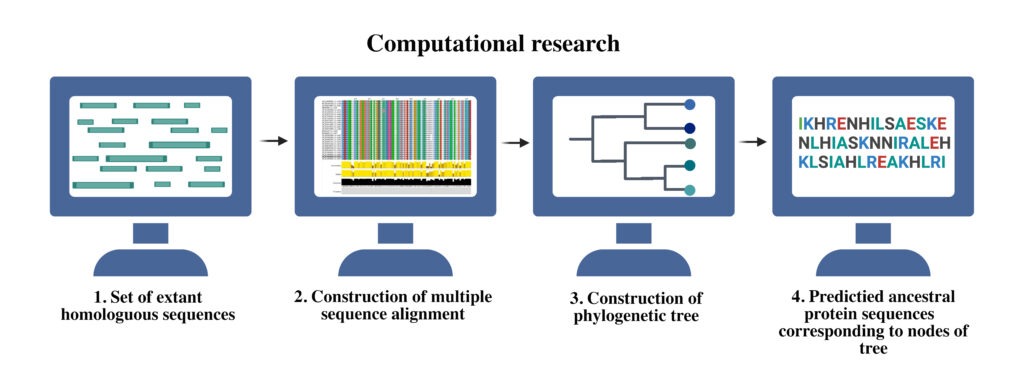
Plastics That Don’t Pollute Our Planet? How Research on Enzyme Optimization Helps To Solve One of the Biggest Challenges of Our Time
Plastic Waste – a Growing Threat:
Since the mid-1950s, plastics have begun their quest to make themselves more and more indispensable in our everyday lives: due to various extremely practical properties and the very inexpensive production, almost everything is now made of plastics, mostly polyethylene (PE), polypropylene (PP) or polystyrene (PS). Plastics package our food, frame our windows and decorate the interior of our cars. We know only too well the price of this triumph: since plastics such as PE and PP only decompose very slowly over centuries, huge mountains of plastic waste are now polluting our environment, harming animals, and even entering our bodies in the form of microplastics. Plastic waste has transformed from a manageable concern into an environmental crisis of monumental proportions. Our once pristine oceans are now marred by vast patches of floating plastic debris, our landscapes are scarred by landfills overflowing with plastic refuse, and delicate ecosystems are suffocating under the weight of plastic pollution. What now?
The global plastic crisis has prompted scientists to explore innovative ways to combat plastic waste, and one promising avenue is the optimization of enzymes for the degradation of plastics like polylactic acid (PLA). In this blogpost, we’ll delve deeper into the fascinating world of enzyme optimization using an approach called ancestral sequence reconstruction, shedding light on how it is revolutionizing our ability to tackle plastic pollution.
PLA – Biodegradable Plastic as a Solution to the Plastic Crisis?
PLA, a biodegradable plastic derived from renewable sources, like corn or sugarcane, is hailed as a more sustainable alternative to petroleum-derived plastics. While petroleum-based plastics require drilling several thousand meters into the earth to source the petroleum, PLA is based on plant matter.
PLA represents a vision of a future where our plastic consumption doesn’t come at the cost of the environment. Yet, the road to sustainability isn’t without its hurdles. While PLA is undoubtedly a more environmentally friendly alternative to traditional plastics, its degradation process still poses challenges. Unlike conventional plastics, which can take centuries to break down, PLA does eventually degrade. However, the pace at which it disintegrates is far from ideal for addressing our immediate plastic waste crisis. The degradation of PLA often requires specific conditions, such as high temperatures and microbial activity, which are not readily available in many environments where plastic pollution is rampant.
Hope Is on the Horizon, but Not Without Further Research…
This is where scientific ingenuity enters the scene. Recognizing the potential of PLA to mitigate plastic waste, researchers are focusing their efforts on optimizing its degradation process. Their goal is to develop enzymes that can catalyse the breakdown of PLA into its constituent components more efficiently, transforming it into harmless substances that can be integrated back into the natural ecosystem. This scientific pursuit is not just about addressing the immediate plastic problem; it’s about redefining our relationship with plastic materials and aligning our innovations with the health of our planet. Let’s learn more about our approach:
Enzymes: Nature’s Tiny Engineers
Enzymes are nature’s molecular catalysts that facilitate chemical reactions vital for life. These remarkable molecules are like artisans, crafting intricate molecular transformations at astonishing speeds. For PLA degradation, enzymes are our allies, capable of disassembling complex plastics into simpler, environmentally friendly components.
But what truly sets enzymes apart is their speed and specificity. While the concept of a chemical reaction might conjure images of slow and laborious processes, enzymes defy this expectation. They work at an incredible pace, often accelerating reactions by factors of thousands or even millions. This remarkable efficiency allows enzymes to power the essential processes that sustain life, from digesting our food to replicating our DNA.
When it comes to the challenge of plastic waste, enzymes become our allies in a new context. Biodegradable plastics, like polylactic acid (PLA), hold promise as a more sustainable alternative to conventional plastics. However, the intricate web of PLA’s molecular structure poses a challenge for natural degradation. This is where enzymes reveal their versatility and adaptability. In the realm of PLA degradation, enzymes take on the role of molecular scissors. They possess the uncanny ability to break down complex PLA structures into simpler, environmentally friendly components (Figure 1). Like master craftsmen, enzymes navigate through the molecular chain of PLA, cleaving bonds, to release its building blocks that are safe for the environment.

Figure 1. Enzymes act like molecular scissors, cleaving PLA plastic into simpler, environmentally friendly components.
This interplay between enzymes and plastic waste signifies a beautiful intersection of science and nature. While we’ve created plastics as products of human ingenuity, we now turn to the ingenuity of nature’s tiniest engineers to undo the impact of our creations. Enzymes offer a glimpse into the incredible adaptability of life on Earth, reminding us that solutions to our most pressing challenges may already exist within the intricate fabric of the natural world.
From Past to Present – Time-Traveling Optimization of Enzymes
In the quest to optimize enzymes for PLA degradation, our research embarks on a genetic journey: We identify ancestral enzymes that might have shown slight PLA-degrading capabilities or possessed traits suggesting adaptability to novel substrates. Resurrection of ancestral enzymes includes computational and experimental research:
To begin this quest, scientists turn to the vast of genetic information contained within databases and the genomes of diverse organisms.

Figure 2: A scheme depicting ancestral sequence reconstruction: Part I: Computational Research
They employ sophisticated bioinformatics tools to sift through this wealth of data, seeking out genes and proteins that exhibit certain key characteristics. These may include structural features, amino acid sequences, or conserved domains that suggest the potential for PLA-degrading capabilities. This is followed by a comparison of the detected sequences using multiple sequence alignment algorithms (Figure 2, image 2).
Scientists then employ phylogenetic analyses, a technique that constructs evolutionary trees, to trace the lineage of these candidate enzymes (Figure 2, image 3).
By examining the evolutionary relationships between different enzymes, they can pinpoint those that have evolved from common ancestors with PLA-degrading traits. This step helps identify enzymes that might have inherited the ancestral “blueprints” for PLA degradation (Figure 2, image 4).
Once potential ancestral candidates are identified through computational methods, experimental validation becomes crucial. Researchers clone and express these candidate genes to produce the enzymes in a laboratory setting (Figure 2, images 5 and 6).

Figure 2: A scheme depicting ancestral sequence reconstruction: Part II: Experimental Research
They then subject these enzymes to rigorous biochemical assays and testing to confirm their PLA-degrading capabilities and assess their efficiency (Figure 2, image 7).
Scientists then delve into the heart of genetic manipulation. They take the sequences of contemporary enzymes used in PLA degradation and perform intricate genetic engineering to mimic the genetic makeup of their ancestral counterparts. This process may involve altering specific amino acids or structural elements to bring the modern enzyme closer to its ancestral form (Figure 2, image 7).
Armed with ancestral genetic blueprints, scientists modify modern enzyme sequences to mimic their ancestral counterparts, aiming to create more stable and efficient enzymes (Figure 3).

Figure 3: Resurrected enzymes are more stable and more specific toward desirable substrate.
The magic of approach called ancestral sequence reconstruction lies in its ability to reveal evolutionary secrets. By dissecting genetic changes that occurred over millions of years, scientists gain insights into how enzymes evolved to decompose complex substances like plastics. It’s a testament to the intricate dance of mutations, natural selection, and functional adaptation.
Imagine peering into the past using the DNA of modern organisms. Ancestral sequence reconstruction enables just that. Scientists analyse genetic sequences of modern enzymes and trace them back to their ancient versions. By comparing these sequences, researchers can decipher the genetic changes that turned these enzymes into efficient plastic-degrading machines.
A Green Revolution – Optimized Enzymes for PLA degradation
Enzyme optimization for PLA degradation isn’t just about improving one molecule’s efficiency. It’s part of a broader movement towards a greener future. Imagine enzymes specifically tailored to break down PLA into its harmless components at an accelerated pace. This means reduced plastic waste and a cleaner environment for generations to come.
Enzymes as Catalysts of Change
The journey from ancestral sequences to optimized enzymes is a testament to the intricate interplay between biochemistry, evolution, and technology. The use of ancestral sequence reconstruction to optimize enzymes for PLA degradation showcases the power of harnessing nature’s wisdom to address modern challenges. As we decode the secrets of enzymes, we gain new tools to shape a sustainable and harmonious coexistence with our environment.
Enzyme Integration: Advancing Bioplastic Waste Management
The improved enzymes resulting from this optimization process can serve a dual purpose in the battle against plastic waste. They can be strategically integrated into the disposal phase, where they are added to PLA waste, especially in waste degradation facilities, to accelerate the degradation of discarded PLA products. Alternatively, these enhanced enzymes can be incorporated into the PLA material during the manufacturing process of plastic products. This ensures that PLA-based products are inherently designed to naturally degrade quickly once they are discarded, reducing their environmental impact and contributing to a more sustainable future.
This post from Biochemist Dr. Aleksandra Maršavelski delves into research done within the framework of her WiRe Fellowship at the University of Münster. For more information about research on fighting plastic pollution, check out another blogpost here from one of our previous fellows, Dr. Maria Laura Ferreira, whose research focusses on bacteria that might be able to degrade certain kinds of mircoplastics.
